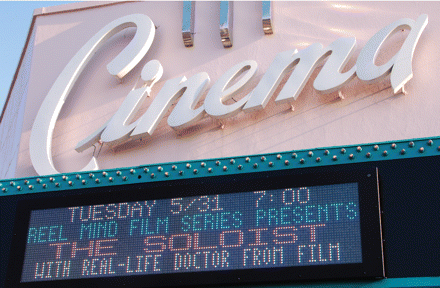Mark Ragins, M.D., says the reason there's no character based on him in the film "The Soloist" is because Johnny Depp wasn't available.
Well, maybe that's not the full story.
"The Soloist" originated when Los Angeles Times columnist Steve Lopez, driving to work, spotted a homeless street person playing the violin under a traffic overpass. The man turned out to be Nathaniel Ayers, once a promising cellist who dropped out of the Juilliard School of Music in the 1970s after developing schizophrenia.
Lopez wrote about Ayers, and then wrote about him again, column after column. Readers soon offered to help. One even donated a cello. Ultimately, the columns became a book, and the book became a movie starring Jamie Foxx as Ayers and Robert Downie Jr. as Lopez.
Ragins, the medical director of MHA Village Integrated Service Agency in Long Beach, Calif., has a modest, if significant role in the book as the voice of psychiatric experience who tries to educate Lopez about the realities of dealing with a seriously mentally ill person.
Apparently undismayed that no one played him in the movie, Ragins spoke in Rochester, N.Y., in May after a screening of "The Soloist" at the Reel Mind Film Series, billed as the movie's "real-life psychiatrist." No one that evening seemed to mind that his insights related to the book and real life rather than the film.
Lopez at first could not understand why Ayers refused antipsychotic treatment and the offer of a free apartment (under Mental Health America's supervision), Ragins told the audience of about 300 at the Cinema Theatre. He explained to Lopez about the resistance of some mentally ill individuals to drug treatment and told him of Ayers' experiences in New York at the time of his initial onset.
Back then, Ayers had been restrained, involuntarily medicated, and given electroconvulsive therapy without his consent, facts left out of the movie, said Ragins. That made him suspicious of psychiatric treatment.
"Eventually, though, [Lopez] was struck that you could have a normal conversation with the person rather than a clinical conversation with the illness," Ragins said.
Ayers ultimately did move into the apartment (depicted in the film) once he was persuaded that it was a good rehearsal space and a safe place to leave his cello. He still does not take medications, said Ragins.
Part of the success of the book and the movie lies in qualities Lopez had as a reporter, qualities also applicable to anyone contemplating a career in psychiatry, Ragins pointed out.
First, interest. Lopez stopped his car to check on a strange-looking man playing the violin beneath a highway overpass.
"Do you want to have a job where you stop when everyone else goes whizzing by?" said Ragins. That's what it takes to be both a good reporter and a good psychiatrist.
Second, commitment. "It's not a hobby," said Ragins. Lopez spent a night on the street with Ayers, even after Ragins told him it was too dangerous.
Third, persistence. Lopez had a hard time convincing Ayers to live in an apartment where he'd be safe and could practice the cello—no surprise to any working clinician.
"Sometimes, you're going to work your butt off, and they're going to refuse," he said. "Are you going to hang in there or will you get frustrated and quit?"
Lopez never quit. Today, he and Ayers remain friends and talk on the phone once or twice a day, said Ragins.

